Understanding Garage Door Motors
Types of Garage Door Motors – Chain drive, belt drive, screw drive, and direct drive motors
In the intricate dance of modern home automation, the garage door motor and chain stand as silent sentinels—reliable yet often overlooked components that underpin daily convenience. It’s astonishing to consider that nearly 80% of residential garages rely on some form of motorised operation, transforming what once was a manual chore into a seamless, almost instinctive act. But beneath this veneer of simplicity lies a fascinating spectrum of technology, each tailored to specific needs and architectural nuances.
Understanding the different types of garage door motors is crucial—each variation embodies a unique synthesis of engineering precision and performance. Chain drive systems, the stalwart workhorses, utilise a robust metal chain that propels the trolley along a track, offering durability at the expense of a slightly noisier operation. Conversely, belt drive motors substitute the chain with a reinforced rubber belt, delivering quieter, smoother motion—ideal for homes where serenity is prized. Screw drive motors, with their helical steel screw, operate through a straightforward yet efficient mechanism, often preferred for their simplicity and lower maintenance requirements. Lastly, the advent of direct drive motors has revolutionised the industry, eliminating the chain or belt altogether and encapsulating the motor within the door itself, resulting in unparalleled quietness and reliability.
- Chain drive: renowned for strength, maintenance, and affordability.
- Belt drive: prized for quiet operation, suited for noise-sensitive environments.
- Screw drive: offers simplicity, durability, and less lubrication needs.
- Direct drive: embodies innovation, with minimal moving parts for maximum longevity.
How Garage Door Motors Work – Basic mechanics and operation principles
In the grand symphony of modern home automation, the garage door motor and chain act as the silent maestros orchestrating daily convenience. Behind the scenes, their mechanics are a marvel of engineering, transforming a simple push or pull into a seamless act. At the core, the motor’s role is to generate controlled rotational force, which is then translated into linear motion—opening or closing the door with effortless grace.
Understanding how garage door motors work involves uncovering their fundamental principles. Typically, these systems employ an electric motor connected to a gear train, which amplifies the rotational energy. For instance, in a chain drive system, the motor turns a sprocket that drives a robust metal chain, pulling the trolley along the track. This chain acts as the vital link between the motor and the door, ensuring smooth and reliable operation.
Within this mechanical ballet, the essential components include:
- The electric motor, which supplies the necessary power.
- The chain or belt, depending on the system, serving as the transmission medium.
- The trolley, acting as the carriage that moves the door along its track.
When activated, the motor’s rotation is transferred through the chain or belt, moving the trolley and ultimately the garage door. This intricate process is governed by safety features and sensors, ensuring the system responds precisely to commands while maintaining safety. For anyone curious about the inner workings of a garage door motor and chain, appreciating these mechanics reveals a hidden world of ingenuity and precision engineering—an invisible force that quietly preserves the rhythm of everyday life.
Factors to Consider When Choosing a Motor – Power, durability, noise level, and compatibility
Choosing the right garage door motor and chain isn’t just about specifications; it’s about understanding how each factor influences the daily rhythm of your home. Power is paramount—without sufficient strength, the motor struggles under load, risking premature wear or failure. Durability, on the other hand, guarantees longevity, especially in varying weather conditions that test the resilience of the chain and motor components. Noise level is often overlooked but can significantly impact your peace, particularly in homes where the garage is near living spaces.
Compatibility is equally critical. Not all garage door motors and chains are universal; selecting a system that aligns with your door’s size and weight ensures smooth operation. When assessing options, consider these elements:
- Motor power ratings
- Chain quality and material
- Operational noise levels
- Compatibility with existing garage door configurations
Ultimately, investing in a high-quality garage door motor and chain means embracing a blend of engineering precision and thoughtful selection—an intersection of reliability and seamless functionality that keeps your home running smoothly day after day.
The Role of Chains in Garage Door Operation
Types of Garage Door Chains – Standard chain vs. roller chain
The chains in a garage door motor and chain system are the unsung heroes that keep your garage door functioning smoothly and reliably. They translate the motor’s power into precise movement, ensuring your door opens and closes seamlessly. Without these chains, the entire operation would grind to a halt, leaving homeowners stranded or forced to manually operate their doors. Understanding the role of chains in garage door operation reveals just how vital these components are to everyday convenience and safety.
When it comes to the types of garage door chains, two primary varieties dominate the market: standard chains and roller chains. Standard chains are typically robust and economical, designed for lighter-duty applications and easy maintenance. Conversely, roller chains — often found in industrial-grade systems — offer enhanced durability and smoother motion, making them ideal for heavier or more frequently used garage doors. The choice between these options depends on factors such as the weight of the door, frequency of use, and desired noise levels.
- Standard chain: Cost-effective, simpler in design, suitable for most residential garage doors.
- Roller chain: More durable, reduced wear over time, suited for high-traffic or heavy garage doors.
Advantages of Chain-Driven Systems – Strength, reliability, and cost-effectiveness
In the intricate ballet of daily life, the garage door motor and chain serve as the silent choreographers, orchestrating seamless access and security. These components embody a union of strength and precision, transforming electrical energy into smooth, controlled movements. The chain’s role is fundamental—acting as the connective tissue that translates motor power into the graceful opening and closing of your garage door. When functioning optimally, they exemplify reliability, often going unnoticed until a hiccup occurs, reminding us of their vital importance.
Advantages of chain-driven systems extend beyond mere functionality. They offer a compelling combination of strength and cost-effectiveness, making them a popular choice for many homeowners. The robust nature of the garage door motor and chain ensures longevity and resilience, even under frequent use or heavier garage doors. Their straightforward design simplifies maintenance, reducing long-term costs and downtime. In essence, a well-maintained chain guarantees a dependable operation, reinforcing security and convenience day after day.
Common Chain Issues – Wear and tear, noise, misalignment, and breakage
The heartbeat of your garage’s security and convenience lies in the relentless rhythm of the garage door motor and chain. Yet, beneath their sturdy exterior, these components are susceptible to the relentless march of wear and tear. Over time, the chain begins to stretch, losing its tautness—a silent indicator that something is amiss. This gradual deterioration often manifests as increased noise, a discordant clatter that echoes with frustration every time you press the remote.
Misalignment is another common challenge faced by garage door chains. When the chain slips or shifts from its proper path, it can cause uneven movement or jamming, disrupting the seamless operation we often take for granted. In these moments, the integrity of the entire system is tested—revealing vulnerabilities that demand attention. Breakage, though less frequent, remains the most critical issue, leaving the garage door immobilised until repairs are made. Regular inspection of the chain’s condition and alignment can prevent these problems from spiralling into costly repairs.
- Wear and tear
- Noise
- Misalignment
- Breakage
Understanding these common chain issues underscores the importance of vigilant maintenance and the resilient design of the garage door motor and chain. When functioning optimally, these systems quietly serve their purpose, but neglect can turn routine operations into frustrating obstacles. The chain’s role is deceptively simple yet vital—translating power into smooth, controlled motion, day after day. Recognising these signs early not only prolongs the lifespan of your garage door motor and chain but preserves the security and peace of mind that every homeowner deserves.
Comparing Garage Door Motor and Chain Systems
Pros and Cons of Chain Drive Motors – Durability, maintenance needs, and noise considerations
When it comes to the humble yet steadfast garage door motor and chain, the debate over chain drive systems continues to evoke passionate opinions—almost as lively as a neighbour’s driveway gossip. Chain drive motors boast commendable durability, often outlasting their belt counterparts by a good few years, making them a favourite for those seeking longevity in their garage door motor and chain setup. However, this robustness comes with a caveat: increased maintenance needs and a propensity for noise that can make early mornings feel like a construction site.
One cannot ignore the symphony of clinks and clatters that accompany a chain-driven system—an audible reminder of its strength but also a potential social faux pas. The wear and tear on the chain can lead to misalignment or breakage if neglected, underscoring the importance of regular inspections. While the cost-effectiveness of chain drive motors remains appealing, especially for larger or heavier garage doors, it’s essential to weigh their advantages against the sometimes disruptive noise and maintenance demands. For those prioritising durability and reliability, a garage door motor and chain might be the stalwart choice—just be prepared for a bit of noise and upkeep along the way.
Alternative Drive Systems – Benefits of belt and screw drive options
When considering the landscape of garage door motor and chain systems, it’s worth exploring the elegant alternatives that belt and screw drives offer. These options often serve as a tranquillising counterpoint to the robust, often thunderous pace of chain-driven mechanisms. Belt drive systems, in particular, whisper softly like a gentle breeze, providing a quieter operation that is prized in homes where mornings should remain undisturbed. Their flexibility and smooth movement are a testament to modern engineering, transforming the garage door from a clattering relic into a ballet of precision.
Meanwhile, screw drive systems boast a simplicity of design, with fewer moving parts that translate into less maintenance and enduring reliability. They excel in environments demanding consistent performance without the cacophony associated with garage door motor and chain arrangements.
- Quiet operation
- Lower maintenance requirements
- Efficient performance over long periods
These attributes make belt and screw drive options compelling alternatives, especially for homeowners seeking harmony between durability and serenity in their garage setup. Ultimately, the choice hinges on balancing the strength of a garage door motor and chain with the whispering promise of quieter, more effortless operation.
Recommended Use Cases for Chain Drive Motors – Heavy doors, frequent use, and budget-friendly options
For heavy garage doors that see frequent use, a garage door motor and chain system remains a popular choice. Its robust construction can handle the rigours of daily operation without faltering. When a garage needs a reliable, long-lasting solution, chain drive motors are often recommended. Their strength and proven durability make them ideal for larger, heavier doors that demand steady performance.
In addition to strength, chain-driven systems tend to be more budget-friendly upfront. This affordability makes them a practical option for homeowners seeking a dependable garage door motor and chain setup without breaking the bank. However, they do produce more noise during operation, which is worth considering if quiet operation is a priority.
- Heavy doors that require substantial force
- High-frequency usage where durability matters
- Cost-sensitive projects demanding reliability
Overall, the garage door motor and chain system excels in environments where performance and longevity are key. While they may be louder than belt or screw drive alternatives, their capacity to withstand wear and tear ensures consistent, dependable operation day after day. For those balancing budget with performance, chain drive motors remain a compelling choice.
Installation and Maintenance Tips
Proper Installation Procedures – Ensuring safety and optimal performance
Proper installation of a garage door motor and chain is essential for safety and long-term performance. When installing, always follow the manufacturer’s guidelines to ensure the system operates smoothly and reliably. Secure mounting brackets firmly and check that the chain has the appropriate tension—too tight can cause strain, while too loose may lead to slipping or misalignment.
A common mistake is neglecting to calibrate the limits correctly; this can result in the garage door not closing or opening fully. It’s also wise to periodically inspect the chain for signs of wear and tear. Proper maintenance includes lubricating the chain and checking for any unusual noise, which may signal misalignment or impending failure.
- Ensure the power supply is disconnected before installation.
- Double-check that all bolts and screws are tightened securely.
- Test the system multiple times to confirm safe, quiet operation.
Regular maintenance not only prolongs the lifespan of your garage door motor and chain but also keeps your garage safe and functional for years to come.
Routine Maintenance Tasks – Lubrication, tension adjustment, and inspection
Maintaining the intricate ballet of your garage door motor and chain is essential to preserving both safety and functionality. Routine tasks, like lubrication and tension adjustment, act as the heartbeats of a well-oiled system, preventing the silent march of wear and tear from spiralling into costly repairs. Regular inspection reveals subtle signs of deterioration—frayed links, unusual noises, or misaligned components—that, if caught early, can save hours of frustration. Proper lubrication, applied with precision and at calculated intervals, reduces friction, prolongs the life of the chain, and ensures the system remains whisper-quiet during operation.
To keep your garage door motor and chain performing optimally, adhere to a disciplined maintenance regimen. An ordered approach might look like this:
- Check and adjust chain tension periodically, ensuring it’s neither too tight nor too loose.
- Lubricate the chain with a high-quality, silicone-based lubricant to prevent corrosion and reduce noise.
- Inspect for signs of wear, such as rust or broken links, and replace components before failure occurs.
In essence, a meticulously maintained garage door motor and chain sustains the delicate balance between strength and finesse, allowing your garage to operate smoothly and safely, season after season.
Signs It’s Time to Replace or Repair – Unusual noises, slow operation, or system failure
When your garage door motor and chain start exhibiting signs of distress, the stakes are higher than they seem. Unusual noises echoing through the garage or sluggish operation are often the first clues that something’s amiss. These symptoms shouldn’t be ignored; they’re the system’s way of signalling impending failure. A malfunctioning garage door motor and chain not only jeopardise safety but can quickly escalate into costly repairs if left unaddressed.
Early detection is crucial. Look out for indicators such as persistent grinding sounds, jerky movements, or a door that refuses to open smoothly. These are often signs of worn or broken links within the chain or diminishing motor performance. If you notice any of these issues, it’s prudent to consider repair or replacement before the problem worsens. Remember, maintaining the integrity of your garage door motor and chain ensures seamless operation and peace of mind.
Troubleshooting Common Issues
Motor Not Responding – Electrical issues, remote control problems
Electrical issues are among the most common reasons a garage door motor and chain refuse to respond. Power surges, blown fuses, or faulty wiring can disrupt the entire system. If your garage door motor and chain aren’t moving, start by checking the power supply. Sometimes, a simple reset or replacing a fuse fixes the problem quickly.
Remote control problems also frequently cause operational failures. Batteries may be dead or weak, or the remote might need reprogramming. For persistent issues, inspect the receiver on the garage door motor and chain for any damage or misalignment.
- Interference from other electronic devices
- Damaged remote control buttons
can also interfere with proper communication.
In some cases, the motor’s circuit board may be faulty or worn out, requiring professional diagnosis. Troubleshooting these electrical issues can save time and money, especially when dealing with a vital component like the garage door motor and chain. Recognising these signs early helps prevent further damage and ensures smooth operation.
Chain Jamming or Slipping – Misalignment, worn components
When a garage door refuses to move smoothly, it’s often a sign that something is amiss within the intricate dance of mechanics—particularly with the garage door motor and chain. Chain jamming or slipping isn’t merely an inconvenience; it can indicate misalignment or worn components that threaten the structural integrity of your system. Over time, the relentless cycles of opening and closing cause wear that, if left unchecked, escalate into more severe malfunctions.
Misalignment is a frequent culprit behind chain issues, causing the chain to slip or jam unexpectedly. This usually results from loose or improperly tensioned chains, which can be diagnosed by observing irregular movement or unusual noises during operation. Worn sprockets or links compound the problem, gradually eroding the system’s efficiency. To address these issues, consider inspecting the chain tension—an essential factor for smooth operation—and look for signs of excessive wear or damage.
Sometimes, the cause resides in the chain’s connection to the motor. A misaligned or damaged garage door motor and chain can result in sudden slips or complete failure to lift the door. Regular lubrication and tension adjustments can often remedy minor misalignments, but persistent issues might necessitate professional assessment to prevent further deterioration of vital components.
Unusual Noises – Grinding, squeaking, and their causes
Unusual noises such as grinding and squeaking are often the first signals that something is amiss within your garage door motor and chain system. These sounds can be haunting, a testament to underlying issues that gradually erode the smooth operation of your garage door. The grinding noise typically indicates worn or damaged components, like sprockets or links, struggling to mesh correctly. Meanwhile, squeaking may be a sign of insufficient lubrication or excessive friction that, if ignored, can lead to more severe malfunctions.
To troubleshoot, it’s helpful to understand the root causes. For example, a misaligned chain can cause irregular movement and noise, while worn bearings or pulleys can generate squeaking sounds. Regular inspection of the garage door motor and chain—listening carefully for changes in tone or volume—can prevent costly repairs down the line. If these issues persist despite lubrication and tension adjustments, it might be time to consult a professional. After all, the integrity of your system hinges on the delicate balance between mechanical parts working in harmony.
Choosing the Right Garage Door Motor and Chain for Your Needs
Factors to Consider – Door weight, frequency of use, budget
In the shadowed corridors of modern homes, the garage door motor and chain often serve as silent sentinels—guardians of privacy and security. Yet, selecting the appropriate system requires more than a cursory glance. The weight of your door, the frequency of its invocation, and your budget are the dark secrets that dictate your choice. Heavy doors demand robust, high-torque motors, while homes with lighter doors may find a more delicate, whisper-quiet system sufficient.
When considering a garage door motor and chain, it’s essential to balance power with longevity. For frequent use, a durable, reliable chain-driven system offers unmatched strength, but it may come with increased noise. Conversely, belt drives whisper softly yet may lack the brute force needed for particularly heavy doors. The key is to envision your garage’s needs as a delicate dance between resilience and serenity—an artful balance that ensures seamless operation amidst the shadows of daily life.
Top Brands and Models – Trusted manufacturers and customer reviews
When it comes to safeguarding your fortress of solitude, the right garage door motor and chain can feel like choosing a knight for your castle—strong, dependable, and quietly vigilant. Top brands such as Chamberlain, LiftMaster, and Genie have earned their reputations not just through marketing mumbo jumbo but genuine customer praise. Their models often feature innovative safety measures, smooth operation, and durability that can withstand the rigours of daily life—or at least a few years of heavy use.
For those who prefer a bit of a thrill with their garage door experience, a chain-driven system remains the unmatched champion in strength and reliability. Its robust construction means it’s particularly suited for heavy doors and frequent use—think of it as the workhorse of garage door motors. However, don’t expect it to operate in complete silence; the metallic symphony of a chain drive can sometimes be heard echoing through the neighbourhood.
Choosing the perfect garage door motor and chain involves balancing these qualities along with your budget. Whether you lean towards a high-torque chain system or a quieter belt alternative, understanding the top models and their unique features will help you make an informed decision. After all, your garage isn’t just a storage space—it’s a portal to your everyday life, and its guardians deserve the best.
Professional vs. DIY Installation – When to seek expert help
When it comes to selecting the perfect garage door motor and chain, the decision often hinges on whether to opt for professional installation or a DIY approach. While many homeowners are tempted by the allure of saving money and tackling the project themselves, it’s essential to recognise when expert help becomes indispensable. Garage door systems are intricate, and improper installation can lead to safety hazards or costly repairs down the line.
Professional installation ensures that your garage door motor and chain are calibrated precisely, reducing the risk of misalignment or operational issues. Experts have the tools and experience to handle complex wiring and safety features, giving you peace of mind. Conversely, a DIY installation might suit those with a knack for mechanical tasks, provided they follow manufacturer instructions meticulously. For straightforward setups, a step-by-step guide can be sufficient, but for heavy or complex doors, seeking professional assistance is often the wisest choice. After all, a well-installed garage door system is a silent guardian that should operate flawlessly, day after day.




0 Comments